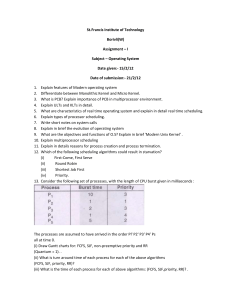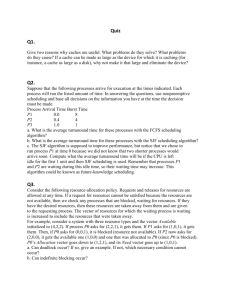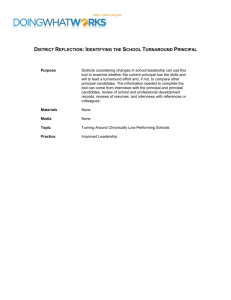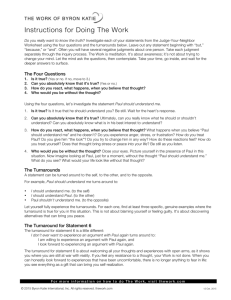Operating Systems: CPU Scheduling Solutions
advertisement
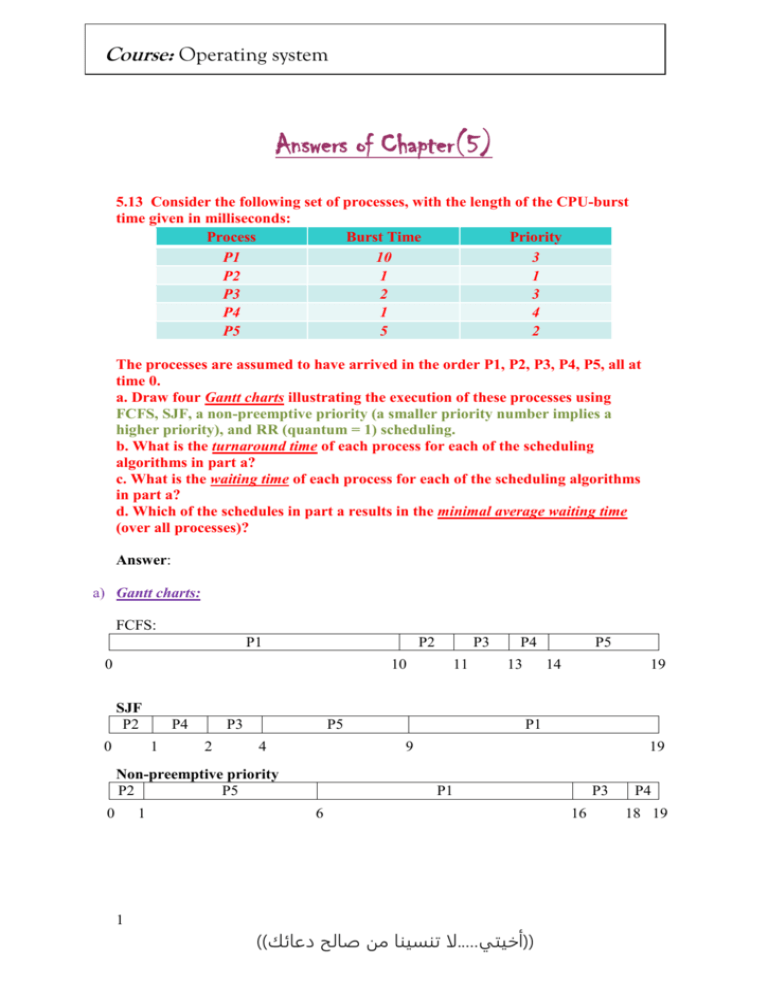
Course: Operating system Answers of Chapter(5) 5.13 Consider the following set of processes, with the length of the CPU-burst time given in milliseconds: Process Burst Time Priority P1 10 3 P2 1 1 P3 2 3 P4 1 4 P5 5 2 The processes are assumed to have arrived in the order P1, P2, P3, P4, P5, all at time 0. a. Draw four Gantt charts illustrating the execution of these processes using FCFS, SJF, a non-preemptive priority (a smaller priority number implies a higher priority), and RR (quantum = 1) scheduling. b. What is the turnaround time of each process for each of the scheduling algorithms in part a? c. What is the waiting time of each process for each of the scheduling algorithms in part a? d. Which of the schedules in part a results in the minimal average waiting time (over all processes)? Answer: a) Gantt charts: FCFS: P1 P2 0 10 SJF P2 0 P4 1 P3 2 1 11 P5 4 P4 13 P5 14 19 P1 9 Non-preemptive priority P2 P5 0 P3 19 P1 6 1 ))لا تنسينا من صالح دعائك.....((أخيتي P3 16 P4 18 19 Course: Operating system RR (quantum = 1) P1 P2 P3 P4 P5 P1 P3 P5 P1 P5 P1 P5 P1 P5 P1 0 1 2 3 4 5 6 7 8 9 10 11 12 13 14 b) Turnaround time = finish time- arrival time OR: Turnaround time = CPU burst time+ wait time By using the first law (Turnaround time = finish time- arrival time) and getting finish time from Gantt chart: Turnaround time P1 P2 P3 P4 P5 FCFS RR SJF Priority 10-0=10 11 13 14 19 19-0=19 2 7 4 14 19-0=19 1 4 2 9 16-0=16 1 18 19 6 c) Waiting time = Turnaround time - CPU burst time Waiting time P1 P2 P3 P4 P5 Average waiting time FCFS RR SJF Priority 10-10=0 10 11 13 14 9.6 19-10=9 1 5 3 9 5.4 19-10=9 0 2 1 4 3.2 16-10=6 0 16 18 1 8.2 d) The minimal average waiting time is found in SJF algorithm **** 5.17 Suppose that the following processes arrive for execution at the times indicated. Each process will run the listed amount of time. In answering the questions, use non-preemptive scheduling and base all decisions on the information you have at the time the decision must be made. Process Arrival Time Burst Time P1 0.0 8 P2 0.4 4 2 ))لا تنسينا من صالح دعائك.....((أخيتي 19 Course: Operating system P3 1.0 1 (a) What is the average turnaround time for these processes with the FCFS scheduling algorithm? (b) What is the average turnaround time for these processes with the SJF scheduling algorithm? (c) The SJF algorithm is supposed to improve performance, but notice that we chose to run process P1 at time 0 because we did not know that two shorter processes would arrive soon. Compute what the average turnaround time will be if the CPU is left idle for the first 1 unit and then SJF scheduling is used. Remember that processes P1 and P2 are waiting during this idle time, so their waiting time may increase. This algorithm could be known as future-knowledge scheduling. Answer: a) Average turnaround time with FCFS : We need to draw the Gantt chart to find the finish time then calculate the turnaround time (Turnaround time = finish time- arrival time) P1 P2 0 P3 12 13 8 P1 P2 P3 Average turnaround time turnaround time 8-0=8 12-0.4=11.6 13-1=12 10.53 b) Average turnaround time with SJF : We need to draw the Gantt chart to find the finish time then calculate the turnaround time (Turnaround time = finish time- arrival time) P1 0 P1 P2 P3 Average turnaround P3 P2 8 9 13 turnaround time 8-0=8 13-0.4=12.6 9-1=8 9.53 3 ))لا تنسينا من صالح دعائك.....((أخيتي Course: Operating system time c) Average turnaround time with future-knowledge scheduling. We need to draw the Gantt chart to find the finish time then calculate the turnaround time (Turnaround time = finish time- arrival time) P3 1 0 P2 2 P1 P2 P3 Average turnaround time P1 6 14 turnaround time 14-0=14 6-0.4=5.6 2-1=1 6.87 **** 5.9 Which of the following scheduling algorithms could result in starvation? a. First-come, first-served b. Shortest job first c. Round robin d. Priority Answer: In FCFS algorithm, all jobs is executed in sequence & no job will wait for infinity to be executed So, No starvation SJF could make some long jobs wait for infinity to be executed if shorter jobs continuously arrive to the ready queue So, SJF could result in starvation. RR treats all jobs equally and no job will wait for infinity to be executed So, No starvation Priority algorithm could make some low-priority jobs wait for infinity to be executed if higherpriority jobs continuously arrive to the ready queue So, Priority algorithm could result in starvation. Finally, Shortest job first (SJF) and priority-based scheduling algorithms could result in starvation. **** 5.7 Explain the differences in the degree to which the following scheduling algorithms discriminate in favor of short processes: a. FCFS b. RR c. Multilevel feedback queues Answer: a. FCFS—discriminates against short jobs since any short jobs arriving after long jobs will have a longer waiting time. 4 ))لا تنسينا من صالح دعائك.....((أخيتي Course: Operating system b. RR—treats all jobs equally (giving them equal bursts of CPU time) so short jobs will be able to leave the system faster since they will finish first. c. Multilevel feedback queues work similar to the RR algorithm— they discriminate favorably toward short jobs. **** 5.8 Consider the exponential average formula used to predict the length of the next CPU burst. What are the implications of assigning the following values to the parameters used by the algorithm? a. α= 0 and τ0 = 100milliseconds b. α= 0.99 and τ0 = 10milliseconds Answer: a) Τn+1= α * tn + (1- α) * τn When α = 0 andτ0 = 100 milliseconds, the equation will be: Τn+1= 0* tn + (1- 0) * 100 = 100 milliseconds So, in this case the formula always makes a prediction of (100 milliseconds) for the next CPU burst. b) Τn+1= α * tn + (1- α) * τn . When α = 0.99 and τ0 = 10 milliseconds, the equation will be: Τn+1= 0.99* tn + (1- 0.99) * 10 = [ 0.99 tn + 0.1] milliseconds So, in this case the most recent behavior (tn ) of the process is given much higher weight (99% with comparison to 1%) than the past history associated with the process (τn=10). **** 5.4 What advantage is there in having different time-quantum sizes at different levels of a multilevel queuing system? Answer: Processes that need more frequent servicing, for example, interactive processes such as editors, can be in a queue with a small time quantum (because it has high input/output interrupts). Processes with no need for frequent servicing (e.g. batch process) can be in a queue with a larger quantum, requiring fewer context switches to complete the processing (because it has very low input/output interrupts). So, the multilevel queuing algorithm makes more efficient use of the computer. **** 5 ))لا تنسينا من صالح دعائك.....((أخيتي Course: Operating system Good Luck Reem Al_Salih 6 ))لا تنسينا من صالح دعائك.....((أخيتي
